Introduction to Lidarmos
The world is on the brink of a technological revolution, and at the forefront lies an innovation set to redefine our understanding of LiDAR systems: Lidarmos. As industries evolve and demands for precision grow, traditional methods fall short. Enter Lidarmos—a groundbreaking advancement that promises not only to enhance capabilities but also to pave the way for smarter solutions across various sectors. This exciting leap in technology isn’t just about improving what we already have; it’s about reimagining how we interact with our environment and leverage data in ways previously thought impossible. Let’s dive into this game-changing technology and discover its potential impact on our future.
The limitations of traditional Lidarmos systems
Traditional LiDAR systems have been pivotal in mapping and surveying. However, they come with several limitations that hinder their effectiveness.
First, the cost of these systems can be prohibitively high. This expense often restricts access for smaller companies or startups looking to innovate. Additionally, the complexity involved in operating traditional LiDAR units requires specialized training, creating a barrier for widespread use.
Moreover, traditional LiDAR typically struggles in adverse weather conditions. Rain, fog, or dust can significantly affect data quality and accuracy.
Another significant drawback is the limited range of some devices. Users may find it challenging to capture distant objects due to this constraint.
Integrating data from conventional LiDAR systems into existing workflows can be cumbersome and time-consuming—leading to inefficiencies that many industries cannot afford today.
What is Lidarmos?
Lidarmos is an innovative solution designed to enhance the capabilities of traditional LiDAR systems. Its primary focus is on delivering superior precision and efficiency in spatial data collection.
This advanced technology utilizes a combination of cutting-edge algorithms and high-resolution sensors. As a result, it can capture intricate details that conventional systems often miss.
Unlike standard LiDAR setups, Lidarmos integrates real-time processing. This allows for faster data analysis and immediate feedback during mapping projects.
The system’s versatility makes it suitable for various applications—ranging from urban planning to environmental monitoring. By adapting to different environments, Lidarmos proves itself as a game-changer in the field of geospatial technology.
With its unique features, Lidarmos opens new avenues for innovation across multiple industries. It’s not just another tool; it’s a transformative approach to understanding our world better.
How does Lidarmos work?
Lidarmos operates through an innovative approach that combines advanced algorithms and state-of-the-art sensors. At its core, this technology uses multiple laser beams to capture detailed spatial data rapidly.
Unlike traditional methods, Lidarmos processes information in real-time. This allows for immediate analysis of the environment being scanned. The system captures millions of points per second, resulting in high-resolution 3D maps.
The integration of artificial intelligence enhances its capabilities significantly. AI analyzes the collected data to identify patterns and objects within the scanned area. This boosts efficiency by reducing time spent while enhancing overall accuracy.
Furthermore, Lidarmos is designed with adaptability in mind. It can function effectively across various terrains and conditions. This versatility makes it suitable for a wide range of applications from urban planning to environmental monitoring.
Advantages of Lidarmos over traditional LiDAR technology
Lidarmos stands out for its enhanced data accuracy. Unlike traditional LiDAR systems, which can struggle with interference in complex environments, Lidarmos uses advanced algorithms to filter noise effectively.
Another key advantage is its speed. The rapid data processing capabilities of Lidarmos allow for real-time analysis. This means users can make quicker decisions based on up-to-date information.
Cost efficiency is also noteworthy. By reducing the need for extensive hardware and maintenance, Lidarmos lowers operational expenses significantly compared to older technologies.
Additionally, the versatility of Lidarmos cannot be ignored. It seamlessly integrates into various applications—from autonomous vehicles to smart city planning—making it a valuable asset across multiple industries.
The user-friendly interface enhances accessibility as well. Operators find it easier to interpret results without requiring specialized training or extensive technical knowledge.
Real-world applications of Lidarmos
Lidarmos is already making waves across various sectors. In agriculture, it enhances precision farming by mapping fields and monitoring crop health in real-time. This technology allows farmers to optimize resources and increase yield.
In urban planning, Lidarmos assists city officials in designing smarter infrastructure. By providing detailed topographical data, planners can create more efficient layouts that minimize traffic congestion and improve public spaces.
The construction industry benefits from Lidarmos as well. It streamlines project management by offering accurate site measurements and terrain analysis, reducing delays during development phases.
Environmental monitoring stands to gain significantly too. Researchers use Lidarmos to track deforestation or habitat changes over time, contributing crucial insights for conservation efforts.
These diverse applications demonstrate how Lidarmos not only improves efficiency but also fosters innovation across industries.
Future potential and impact on various industries
The future potential of Lidarmos is vast. As industries embrace digital transformation, the demand for advanced technology grows.
In agriculture, precision farming can be enhanced with Lidarmeos. Farmers can monitor crop health and soil conditions in real-time, leading to better yields and sustainable practices.
Urban planning will also benefit significantly. City planners can utilize Lidarmeos data to design smarter infrastructure that reduces traffic congestion and increases safety.
Additionally, the construction sector stands to gain from improved surveying capabilities. Accurate topographical data accelerates project timelines while minimizing costs.
Environmental monitoring could see a revolution as well. With its ability to gather detailed information about ecosystems, Lidarmeos will aid in conservation efforts by tracking changes over time.
Healthcare applications are emerging too. Enhanced imaging capabilities may lead to breakthroughs in medical diagnostics and treatment planning.
Each industry presents unique opportunities where Lidarmeos can drive efficiency and innovation forward.
Conclusion: The exciting future of Lidarmos and its potential for a smarter world
As we look towards the future, Lidarmos stands as a beacon of innovation in LiDAR technology. Its advanced features have already begun to reshape industries ranging from autonomous vehicles to urban planning. By overcoming the limitations of traditional systems, Lidarmeos offers enhanced accuracy and efficiency that promise smarter solutions for complex challenges.
The potential applications are vast and varied. Imagine cities with optimized traffic flow or construction projects completed more rapidly while minimizing environmental impact. The integration of Lidarmeos could enhance safety measures, facilitate better resource management, and even support climate change initiatives through precise data collection.
With ongoing advancements on the horizon, it is clear that Lidarmeos is not just a passing trend; it’s an essential part of our technological evolution. As businesses and governments harness its capabilities, we may find ourselves stepping into a world where data-driven decisions lead to improved quality of life for all. The journey has only just begun, but the path ahead looks promising with Lidarnos leading the charge toward a smarter future.
Find your next favorite read—Vehicle DART has something special just for you!

